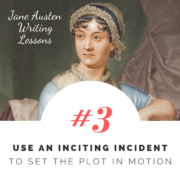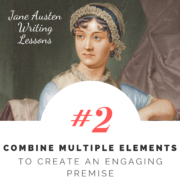Full Sized Blog Element (Big Preview Pic)
#3: Use an Inciting Incident to Set the Plot in Motion
/4 Comments/in Jane Austen Writing Lessons/by Katherine Cowley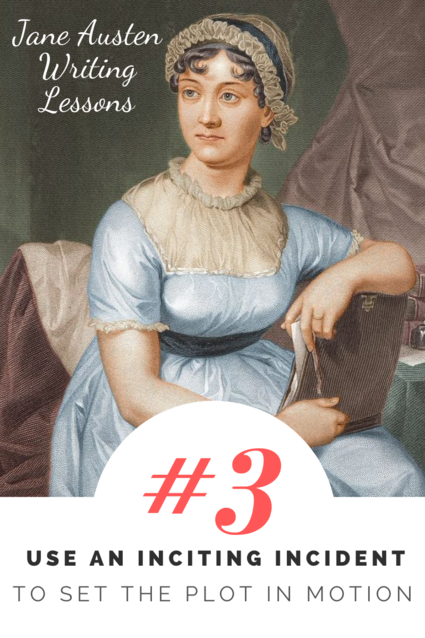
One of my all-time favorite films is Austenland. It’s a comedy about a woman named Jane who spends her savings to stay at an all-inclusive, Jane Austen-themed resort. At one point in the film, she and another character, Mr. Nobley, find themselves running.
Mr. Nobley asks, “Why are we running?”
Jane replies, “Because a man and a woman should never be alone unless they are in motion.”
Just like characters in the Regency period (or anyone in an immersive Jane Austen experience), stories themselves should not be at rest.
Stories are generally about motion, they are about change and development, both in terms of character and plot. Yet as humans, we are stationary beings. We do what we have been doing: we stay still, or, if we have a path, we stick to that path unless something changes.
An inciting incident is an event that carries weight for the main character and creates the opportunity for change, both internally and externally. An inciting incident often introduces forces outside of the main character’s control, and is a disruption that requires the main character to adapt and grow and interact with others in new ways. An inciting incident often relates, in some way, to the main themes or conflicts of the novel.
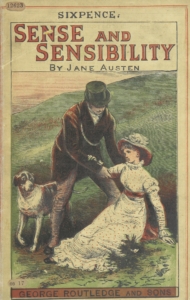
1884 cover of Sense and Sensibility, from the British Library
In Sense and Sensibility, Mr. Dashwood’s death changes everything for Mrs. Dashwood and her daughters, Elinor, Marianne, and Margaret. Yet for a time, they stay in stasis, continuing to live on the estate that has been their home. Yet it is no longer really their home: Mrs. Dashwood’s stepson, Mr. John Dashwood, and his wife, Fanny Dashwood, are the new owners. Fanny in particular makes the elder Mrs. Dashwood and her daughters unwelcome, especially once she notices that her brother, Edward Ferrars, is interested in Elinor. She rudely confronts Mrs. Dashwood on the subject, and Mrs. Dashwood decides that they will withdraw from the estate:
To quit the neighborhood of Norland was no longer an evil; it was an object of desire; it was a blessing, in comparison of the misery of continuing her daughter-in-law’s guest: and to remove for ever from that beloved place would be less painful than to inhabit or visit it while such a woman was its mistress.
As they leave, Marianne wails a lament:
“Dear, dear Norland! when shall I cease to regret you!—when learn to feel a home elsewhere!—Oh! happy house, could you know what I suffer in now viewing you from this spot, from whence perhaps I may view you no more!….you will remain the same; unconscious of the pleasure or the regret you occasion, and insensible of any change in those who walk under your shade!—But who will remain to enjoy you?”
This forced eviction takes the Dashwoods on a physical journey—to a new county, where they live in a cottage and meet a whole set of new people. In addition to a physical journey, it’s also a journey to try to find home and to see if they can survive losing almost everything that they find dear. This journey starts both Marianne and Elinor on internal journeys; Marianne is full of sensibility and unrestrained emotion, but must learn how to let more than her emotions govern her; Elinor has a bit too much sense, and keeps too much inside her, not allowing herself to want and hope for the things she really desires.
While some inciting incidents lead to physical journeys, like in Sense and Sensibility, a physical journey is not required. For instance, in Emma the inciting incident is the marriage of Emma’s governess. Emma’s internal and external journeys are captivating, but they do not require her to leave her home (the furthest she goes is Box Hill, which is only seven miles away).
Change is at the heart of interesting plots, and the possibility for change is why we root for characters. A good inciting incident sets the plot in motion and paves the way for the rest of the story.

Exercise 1: Choose one of your favorite books or movies. What is the inciting incident? How does this event change things for the main character and start them on a journey? Share your thoughts in the comments.
Exercise 2: In the following paragraph, a character is pursuing something she wants: the opportunity to be the pianist for the high school musical. Add an inciting incident, something that will disrupt and change things for Luciana. For the purposes of this exercise, keep it short—anywhere from a sentence to a full paragraph. Once you’ve written the inciting incident, consider how it would change the character’s trajectory and what sort of story might result from it.
Luciana ran her fingers up and down the keys of an imaginary piano. She had been preparing for this audition for months, and now the time had finally come. She closed the book and looked at her hands. They were warm, they were flexible, and they were ready. She would be chosen as the accompanist for the high school musical this year, surely. She waited impatiently for her turn on the grand piano, but she need not have worried. Luciana played the music flawlessly, and the music director gave her an assuring smile as she left the room.
Exercise 3: Take a new story idea, one that you haven’t yet developed. Spend a few minutes brainstorming an inciting incident, or, if you prefer discovery writing, write an opening scene and see what inciting incident will put your character in motion or change her direction.
#2: Combine Multiple Elements to Create an Engaging Premise
/0 Comments/in Jane Austen Writing Lessons/by Katherine Cowley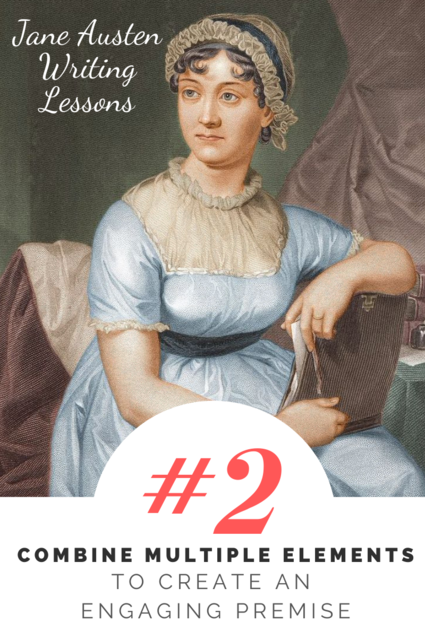
There’s a popular Studio C comedy skit called “Teddy’s Story Joint.” In it, authors go to a story restaurant and buy their plots. The first author to visit is Jane Austen, who says, “I’d like a plot today. The usual.”
A new employee asks her boss, “What’s the usual?”
He explains what Jane Austen is looking for: “Girl likes a guy. Looks like she won’t get the guy, but then she does.” He turns to Jane Austen and asks, “With the witty social critique on the side?”
Jane Austen smiles and says, “You know how I like it.”
Arguably, there might only be seven basic plots, but obviously there’s a lot more to Jane Austen than this very basic plot structure found at the core of her novels. How do you do this in your own writing: how can you make your stories different from all the other stories out there?
While almost every idea has been “done before” in some way or another, if you’re brainstorming or developing a concept it’s useful to combine multiple elements to create an engaging and original premise.
Take Jane Austen’s Persuasion as an example. Yes, it’s a love story with hiccups—but it’s so much more than that.
Here are some of the key elements that together make it a fascinating premise:
Anne Elliot is the unloved, ignored sister
Anne was engaged ten years before, to Frederick Wentworth, but she broke off the engagement
Anne is losing her home…which is being rented by Wentworth’s family
Wentworth returns, but he’s not interested in Anne—he’s interested in not just one, but two other women

The two penguins fighting over Wentworth’s heart are Louisa and Henrietta Musgrove. Anne Elliot is the penguin on the top left, trying hard to not watch. (Penguins from the California Academy of Sciences.)
Persuasion incorporates lost love, jealousy, longing, misunderstandings, the pain of betrayal, and family conflict. It’s an engaging concept, even when written in bullet point form. The elements are distinctive and focused, they can be explained quickly and easily, and they paint a picture of the character, plot, and conflict.
How do you create an engaging premise or concept?
Take the kernel of your story idea—whether it’s a character, a plot idea, a situation, a setting—and start combining it with other things. Consider what happens if you put the story in a different time, use a different genre, or add a different subplot. What happens if you change a key detail about one of the characters? Once you start getting excited about the concept, then you know you have something worth writing.

Exercise 1:
Play the story element mix-up game below. First, choose a genre, then select a main character and a plot element. Add details and craft a pitch for the story’s premise.
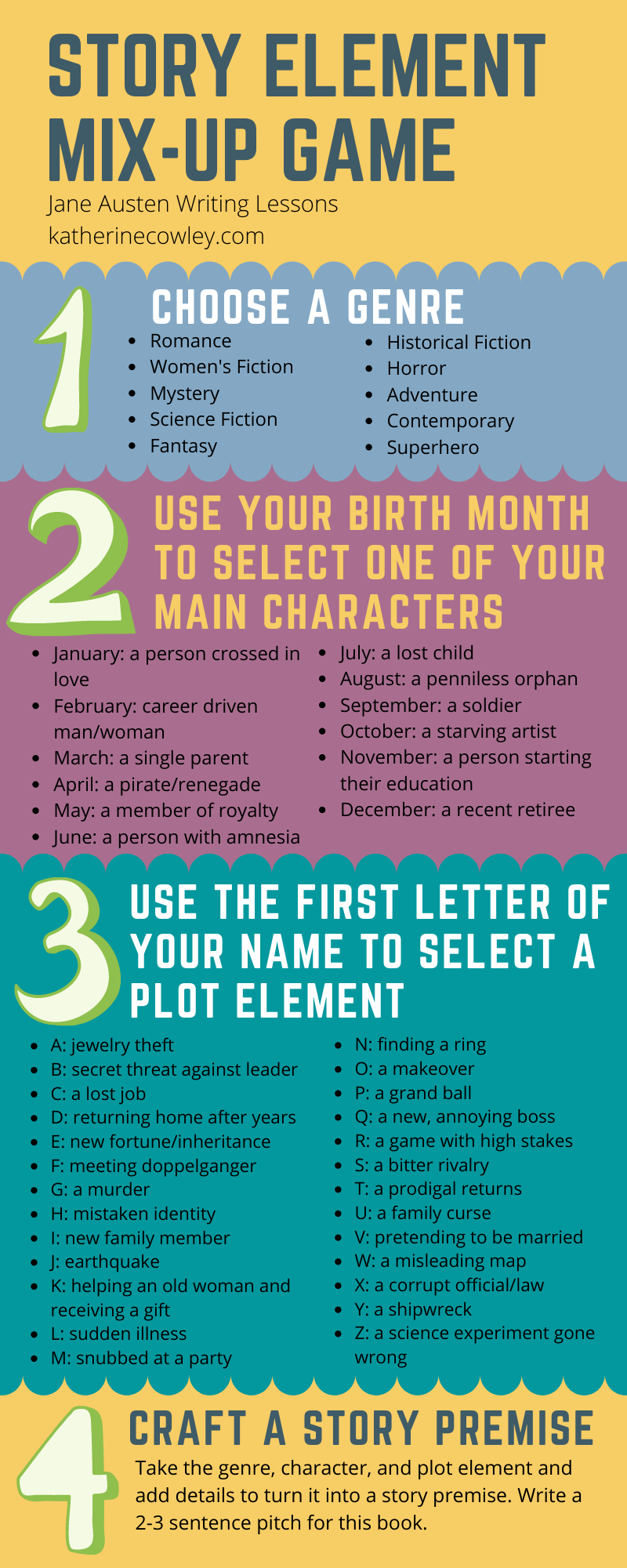
As an example, I have selected the following elements:
- Historical fiction
- Person crossed in love
- Helping an old woman and receiving a gift
Now I will add some additional details in order to craft a story premise:
The widow Lady Gertrude thought she had found love again, but the charming Mr. Wenton was actually a swindler who robbed her of 1000 pounds. Now she is fighting to keep her deceased husband’s estate, while struggling to help the ailing, old housekeeper, Mrs. Winter. Lady Gertrude cares for Mrs. Winter personally, and with her dying breaths Mrs. Winter tells her the location of hidden chest. Inside, Lady Gertrude discovers a family secret: a record of her deceased husband’s disinherited cousin, the scarred and troubled Colonel Anthrop, who may hold the key to saving both the estate and Lady Gertrude’s broken heart.
If you would like to do the exercise more than once, use the birth month and name of a friend, or change the genre. (Or go rogue and choose whichever elements from the chart you would like!)
If I were to create a story premise with the same components but a different genre (superhero), my story premise might look like this:
Angela moves to a small town in the upper peninsula of Michigan to escape her past—and her cheating ex-boyfriend. As she’s moving into an old, one-bedroom apartment, she helps an old woman with her groceries. The brownies the old woman gives her as a thank-you give Angela superpowers, including the ability to sense when a crime is being committed. Soon she discovers a conspiracy involving the famous Tahquamenon Falls, and Angela must use her powers to save her newfound community.
Exercise 2
Brainstorm a list of story ideas. These do not have to be fully developed story ideas—rather, they can be interesting story elements. The film director Michael Rabiger recommends keeping a CLOSAT journal, where you record interesting Characters, Locations, Objects, Situations, Acts, and Themes. These can be from life, from your imagination, from other stories or art, from the news, etc. Once you find a story element you really like, see what you can combine it with to develop a story.
Exercise 3
If you are already working on a short story or a novel, practice writing an elevator pitch: a short, 1-2 sentence pitch about your story that you could give to someone in the length of time you would spend with them in an elevator. Consider which core elements make your premise unique and compelling, and see if you can capture the core conflict of the story in your pitch. As a bonus challenge, pitch your story idea to five different people.

